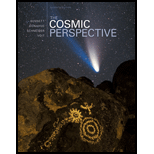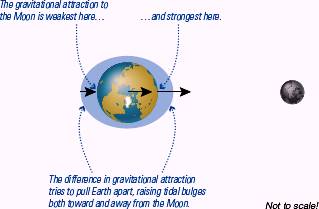
The given figure shows how the Moon causes tides on Earth. Note that the North Pole is in the center of the diagram, so the numbers 1 through 4 label points along Earth’s equator.
What do the three black arrows represent?
A. The tidal force Earth exerts on the Moon.
B. The Moon’s gravitational force at different points on Earth.
C. The direction in which Earth’s water is flowing
D. Earth’s orbital motion
Answer to Problem 1VSC
Solution:
The attraction is Minimum at point 3 which feels least gravitational attraction. Hence option (B) is correct. Since in figure gravitational pull of the Moon on Earth which gives rise to tides and the North Pole is at the center in this diagram and the numbered points are along the circumference of the equator. The black arrows represent the gravitational pull of the Moon on the Earth. The length of arrows denotes the strength of attraction. The arrow is longest at point 1, which is closest to the moon denoting that the attraction is Maximum there.
Explanation of Solution
Introduction:
Visual information used in astronomy shows how the Moon causes tides on Earth. Here in diagram North Pole is in the center of the diagram, so the numbers 1 through 4 label points along Earth’s equator.

In the figure, Tides are created by the difference in the force of attraction between the Moon and different parts of Earth. The two daily high tides occur as a location on Earth rotates through the two tidal bulges. (The diagram greatly exaggerates the tidal bulges, which raise the oceans only about 2 meters and the land only about a centimeter.)
The figure shown above shows the gravitational pull of the Moon on Earth which is responsible for giving rise to tides. At the center in this diagram the North Pole is found and along the circumference of the equator, the numbered points are there. The gravitational pull of the Moon on the Earth is represented by the black arrows. The strength of attraction is denoted by the length of arrows. The arrow is longest at point 1 and that is closest to the moon clearly denoting that the attraction is shown Maximum there. The attraction is Minimum at point 3 and thus feels least gravitational attraction. Hence option (B) is correct. The force exerted by the Moon on Earth denoted by the black arrows. Tidal force can be defined as the “stretching force which acts on a body due to the difference in gravitational attraction on its two opposite ends. Therefore, option (a) is clearly not correct.
The arrows are not denoting the direction flow of water. Hence, option (C) mentioned is also not correct. The black arrows are pointing in the direction of the moon. The orbital motion of Earth is also clearly not towards the Moon. Hence, option (D) is not correct.
Conclusion:
The gravitational pull of the Moon on Earth which gives rise to tides. The black arrows representing the gravitational pull of the Moon on the Earth and length of arrows denotes the strength of attraction. Tidal force is defined as the stretching force that acts on a body due to the difference in gravitational attraction on its two opposite ends.
Want to see more full solutions like this?
Chapter 4 Solutions
The Cosmic Perspective
- Three identical capacitors are connected in parallel. When this parallel assembly of capacitors is connected to a 12 volt battery, a total of 3.1 x 10-5 coulombs flows through the battery. What is the capacitance of one individual capacitor? (Give your answer as the number of Farads.)arrow_forwardSuppose you construct your own capacitor by placing two parallel plates at a distance 0.27 meters apart. The plates each have a surface area of 0.64 square meters. What is the capacitance of this setup? (Give your answer as the number of Farads.)arrow_forwardDraw a diagram with the new arrows. No they do not point all towards the center.arrow_forward
- Example In Canada, the Earth has B = 0.5 mŢ, pointing north, 70.0° below the horizontal. a) Find the magnetic force on an oxygen ion (O2) moving due east at 250 m/s b) Compare the |FB| to |FE| due to Earth's fair- weather electric field (150 V/m downward).arrow_forwardFour charges, qa, qb, qa, and qd are fixed at the corners of a square. A charge q that is free to move located at the exact center of the square. Classify the scenarios described according to the force that would be exerted on the center charge q. Assume in each case that q is a positive charge. Do not assume that the fixed charges have equal magnitudes unless the scenario defines such an equality. qa Яс q %b Force is zero Force is to the left Force is to the right Force is undeterminedarrow_forwardCharge qi = -q is located at position (0, d). Charge q = −2q₁ is located at position (d,0). Charge q3 = located at position (2d, 2d). 5qi is y Determine the net electric field Ĕ net at the origin. Enter your expression using ij unit vector notation in terms of the given quantities, the permittivity of free space €0, and exact rational and irrational numbers. d 9₁ d TH net = 92 d d Xarrow_forward
- solve pleasearrow_forward= = R4 R5 = 12.5 Q. A - In the circuit shown, R₁ = R₂ = R 3 voltmeter measures the potential difference across the battery. When the switch is in position 1, the voltmeter measures V₁ = 13.8 V. When the switch is in position 2, the voltmeter measures V2 = 13.4 V. What is the emf ☐ of the battery? 14.93 = What is the battery's internal resistance r? r = V CH Ω R₁₂ V S R₁ 02 2 R₁ 4 R3 R 5arrow_forwardConsider the arrangement of charges shown in the figure. Four charges of equal magnitude Q but varying sign are placed at the corners of a square as indicated. A positive charge q is placed in the center. What is the direction of the net force, if any, on the center charge? Indicate your answer by placing the appropriate label in the first box. Then, suppose that the charge q were to be displaced slightly from the center position. On the figure, label each box with the arrow that best indicates the direction of the net force that would act on q if it were moved to that location. Net Force Answer Bank no force ↑ +2 0 -Q -Q +Qarrow_forward
- Don't use ai to answer I will report you answerarrow_forwardWhen an electromagnetic wave is reflected at normal incidence on a perfectly conducting surface, the electric fieldvector of the reflected wave at the reflecting surface is the negative of that of the incident wave.a) Explain why this should be so.b) Show that the superposition of the incident and reflected waves results in a standing wave.c) What is the relationship between the magnetic field vector of the incident and reflected waves at the reflectingsurface?arrow_forwardSuppose there are two transformers between your house and the high-voltage transmission line that distributes the power. In addition, assume your house is the only one using electric power. At a substation the primary of a step-down transformer (turns ratio = 1:23) receives the voltage from the high-voltage transmission line. Because of your usage, a current of 51.1 mA exists in the primary of the transformer. The secondary is connected to the primary of another step- down transformer (turns ratio = 1:36) somewhere near your house, perhaps up on a telephone pole. The secondary of this transformer delivers a 240-V emf to your house. How much power is your house using? Remember that the current and voltage given in this problem are rms values.arrow_forward
 College PhysicsPhysicsISBN:9781305952300Author:Raymond A. Serway, Chris VuillePublisher:Cengage Learning
College PhysicsPhysicsISBN:9781305952300Author:Raymond A. Serway, Chris VuillePublisher:Cengage Learning University Physics (14th Edition)PhysicsISBN:9780133969290Author:Hugh D. Young, Roger A. FreedmanPublisher:PEARSON
University Physics (14th Edition)PhysicsISBN:9780133969290Author:Hugh D. Young, Roger A. FreedmanPublisher:PEARSON Introduction To Quantum MechanicsPhysicsISBN:9781107189638Author:Griffiths, David J., Schroeter, Darrell F.Publisher:Cambridge University Press
Introduction To Quantum MechanicsPhysicsISBN:9781107189638Author:Griffiths, David J., Schroeter, Darrell F.Publisher:Cambridge University Press Physics for Scientists and EngineersPhysicsISBN:9781337553278Author:Raymond A. Serway, John W. JewettPublisher:Cengage Learning
Physics for Scientists and EngineersPhysicsISBN:9781337553278Author:Raymond A. Serway, John W. JewettPublisher:Cengage Learning Lecture- Tutorials for Introductory AstronomyPhysicsISBN:9780321820464Author:Edward E. Prather, Tim P. Slater, Jeff P. Adams, Gina BrissendenPublisher:Addison-Wesley
Lecture- Tutorials for Introductory AstronomyPhysicsISBN:9780321820464Author:Edward E. Prather, Tim P. Slater, Jeff P. Adams, Gina BrissendenPublisher:Addison-Wesley College Physics: A Strategic Approach (4th Editio...PhysicsISBN:9780134609034Author:Randall D. Knight (Professor Emeritus), Brian Jones, Stuart FieldPublisher:PEARSON
College Physics: A Strategic Approach (4th Editio...PhysicsISBN:9780134609034Author:Randall D. Knight (Professor Emeritus), Brian Jones, Stuart FieldPublisher:PEARSON





